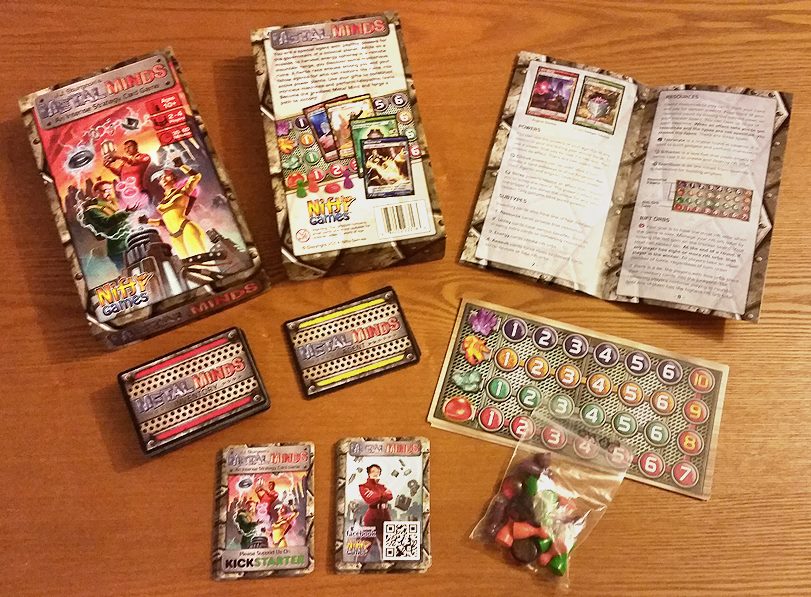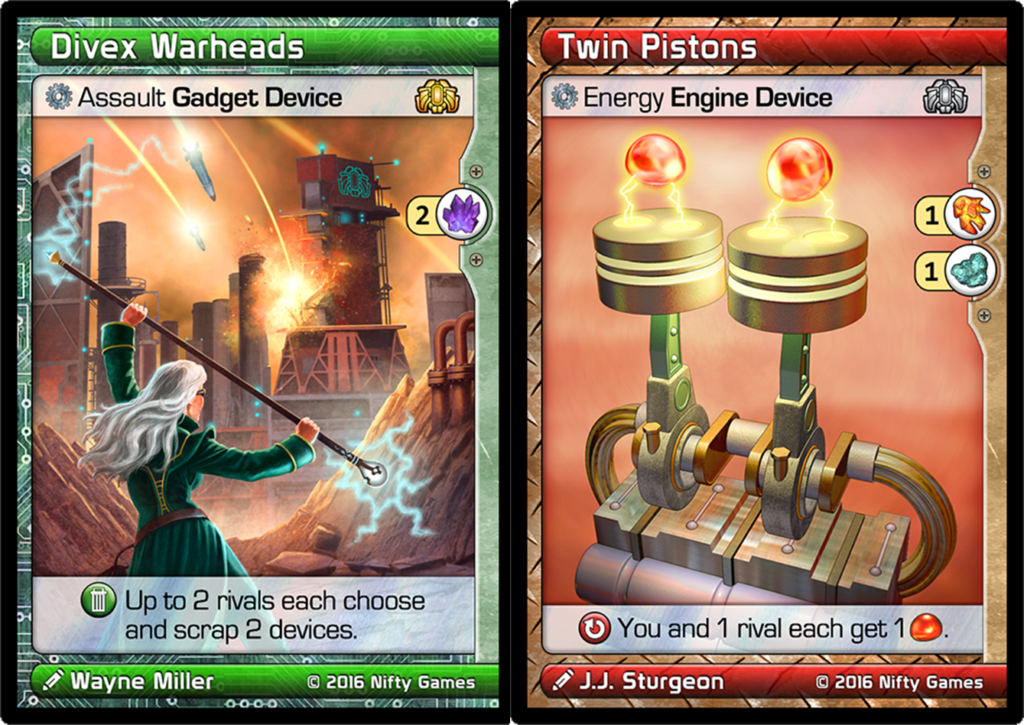Kal-Purnika…a colonial planet’s name that runs right off the tongue. In this make-believe world, this planet is renowned for its technological advances, specifically the ability to infuse minerals into a person’s DNA for the sake of curing diseases and enhancing various mental functions. Unfortunately, treatment is expensive and in exchange for it, the government requires that the individual work for ten years of servitude as a metal mind agent. Players will be competing to rebuild a power plant…the first to do so gets released from this servitude early. Before we begin, I’d like to thank J.J. Sturgeon for reaching out and providing me with a prototype for preview purposes. It’s important to stress that prototypes are not often reflective of the final product, making everything you see featured here (including the rules) subject to change).

Metal Minds: 2-4 Players, Ages 10+, Average Play Time = 30-60 Minutes
My prototype copy came with 12 resource pawns, 4 rift orb gems, 4 tracker boards, 75 inventory cards, and 8 agent cards.
Players begin by choosing an agent (yellow card) at random, which gives them a unique special ability. Ironmine agents convert and get more resources, silverminds draw extra cards, and copperminds can create their own rift orbs. In addition to listing a power, these agent cards define a player’s hand limit and line limit. A line limit is simply how many devices you can have in play before you’re forced to draw cards and end your turn. Players also receive a tracker (number side up), a red gem, and a pawn of each color (purple, orange, and green). The red gem tracks your rift orb totals while the pawns track your resources. Players start with no rift orbs but one of each resource. Lastly, players get a hand of four cards from the inventory deck.
The game is played over a series of rounds. Each round consists of one player taking a full turn. A player’s turn is divided into three phases:
1. Action Stage (optional) – Play cards from your hand, use powers from cards in your line (cards played above your tracker), and/or use the power of your agent. If you skip this step, you get to draw a card or get two resources in any combination.
2. Limit Stage – Discard down to your hand and line limits.
3. Draw Stage – Rotate all devices and your agent vertically and draw the top two cards from the inventory deck.
When it comes to cards, there’s a few different types. Blue cards are called maneuvers and are played for a one-time effect after paying the resource cost, if one exists. Devices are either red or green, red being able to be used once per turn until they leave your line while green devices can only be used once. Devices cannot be utilized on the same turn they are added to the line. Once again, they have a resource costs that must be observed.

Ultimately, your goal is to have the most rift orbs when the game is over. To do that, you’ll be earning and paying resources to play and activate cards/powers respectively. A rift maker device, for example, requires the user to pay one yellow resource to create an orb using an action during phase one. The game ending condition is met whenever one player has at least eight orbs, in which that round is played out so that everyone has an equal number of turns. Whoever has the most orbs (max 10), wins the game!
“Metal Minds” was received well in our household. The overall premise is fairly simple in that you’re collecting resources to activate powers that ultimately allow you to complete your goals. With that said, there’s a bit of strategy involved. You might have a great card in your hand that you can’t play yet, so you might be tempted to skip a few action phases to gain the resources you need to play it. On the other hand, some card effects allow players to scrap other players’ cards so leaving a high-valued card out on your line all by its lonesome is a risky business. There’s also discard effects, so it’s advised that you don’t wait too long to play a card you really want from your hand. It comes down to timing really and how to best utilize your turns so that your plan flows smoothly with the least amount of risk for the most gain.
I also appreciate the different agent powers as they each will change how you decide to run things. One character’s power might be heavily used throughout the game while others might require you to wait to use them until the current situation calls for it. In other words, some powers are no-brainer buffs while others require a bit more finesse and tactical planning. Depending on who you get, you may end up changing up your strategy and play style completely.
“Metal Minds” hits that sweet spot in terms of being easy to play but yet still requires some thought. I personally love those kinds of games as they can be played “after homework” and “before bed”, two dad terms you’ll be very familiar with if you happen to be a parent. While my copy was a prototype, I felt that the art was pretty well done. I can’t wait to see what the final production copy will end up looking like. Vinnie Jr., my regular sidekick when it comes to reviewing games, really enjoyed this one too and understood the rules almost immediately. As such, I think “Metal Minds” would be an excellent addition to any family’s collection, though it would be even more awesome if it supported up to five players instead of four.
—
You can learn more about and support the game on Kickstarter here:
